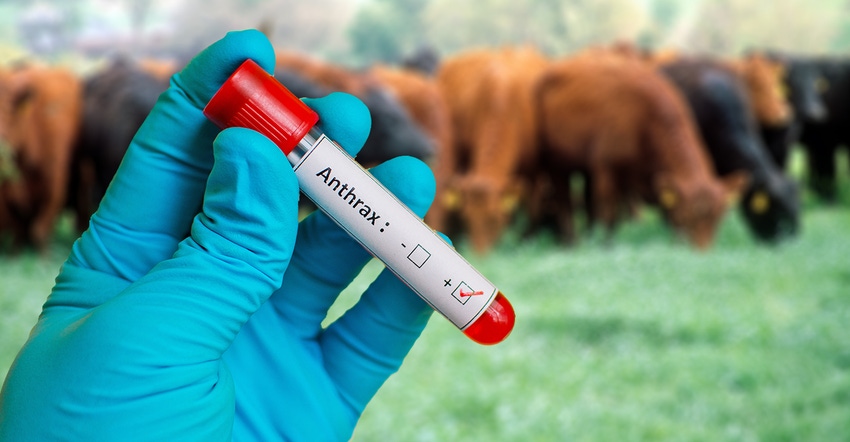June 3, 2019

North Dakota’s state veterinarian says conditions are right for anthrax.
The disease occurs most commonly following heavy rainfall. The spores lie dormant in the soil and animals are exposed when they graze or consume forage or water contaminated with the spores.
Some anthrax cases are reported in North Dakota every year. But in 2005, more than 500 confirmed deaths from anthrax were reported, with total losses estimated at more than 1,000 head. Affected animals included cattle, bison, horses, sheep, llamas, and farmed deer and elk.
You can vaccinate livestock against anthrax, according to Susan Keller, North Dakota state veterinarian. It takes about a week for immunity to be established, and the vaccine must be administered annually to maintain protection.
Keller suggests talking to your veterinarian to make sure your animals are current on their anthrax vaccination schedule. Also, monitor herds closely and report unexplained deaths to your veterinarian early to seek a diagnosis.
“Even if not anthrax, it’s important to attempt to determine the cause of death to prevent other potential losses,” Keller says.
Anthrax symptoms
Symptoms associated with anthrax depend to a certain degree on the species involved and the route of infection. When the anthrax organism enters the animal’s body through the mouth or nostrils, the symptoms occur soon after infection (acute form) and death follows rapidly. When infection takes place through the skin because of injury or insect bites, it appears localized at the site of injury in the initial stage. The affected area initially is hot and swollen and becomes cold and insensitive. Later, the infection can become generalized.
Animal anthrax usually is a fatal disease with no symptoms observed. Upon or near death, blood oozes from the body openings. This blood is heavily laden with anthrax organisms. The carcass has a marked bloating and decomposes rapidly.
If the infection is less acute, the animal may stagger, have difficulty breathing, tremble, collapse and die. In horses, colic may be observed. Edema and swelling may be seen over the body, particularly at the brisket. Illness is observed for one or two days, but it may last five days; symptoms are preceded by fever, with a period of excitement in which the animal may charge anyone nearby. This is followed by depression in cattle or sheep.
Sometimes the anthrax organism localizes itself in the throat area. The tongue, throat and neck are extremely swollen, and a frothy blood-tinged discharge comes from the mouth. Although this is the typical form of anthrax observed in swine, it also may occur in cattle and sheep.
Anthrax diagnosis
Not all cases of “sudden death” are anthrax. If livestock owners suspect anthrax, though, they need to have a confirmatory laboratory examination.
If anthrax is suspected, have a veterinarian collect a jugular sample of venous blood and send or deliver it to the diagnostic laboratory in a sealed, sturdy, leak-proof, iced container with an accompanying history identifying it as an anthrax suspect. The Veterinary Diagnostic Laboratory at North Dakota State University has anthrax specimen collection kits available for veterinarians to submit samples safely.
For more information about anthrax, visit the North Dakota Department of Agriculture website.
Sources: North Dakota Department of Agriculture and North Dakota State University Extension Service, which are solely responsible for the information provided and is wholly owned by the source. Informa Business Media and all its subsidiaries are not responsible for any of the content contained in this information asset.
You May Also Like




